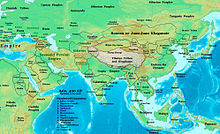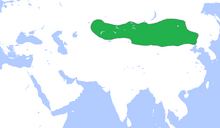Rouran Khaganate
|
Rouran Khaganate
|
|||||||||||||
|---|---|---|---|---|---|---|---|---|---|---|---|---|---|
| 330 AD–555 AD | |||||||||||||

Rouran Khaganate in Central Asia
|
|||||||||||||
| Status | Khanate | ||||||||||||
| Capital | Mumo city, Orkhon River, Mongolia | ||||||||||||
| Common languages | Ruanruan Mongolian Chinese |
||||||||||||
| Religion
|
Tengrism Shamanism Buddhism |
||||||||||||
| Khagan | |||||||||||||
|
• 330 AD
|
Yùjiǔlǘ Mùgǔlǘ | ||||||||||||
|
• 555 AD
|
Yujiulü Dengshuzi | ||||||||||||
| Legislature | Kurultai | ||||||||||||
| History | |||||||||||||
|
• Established
|
330 AD | ||||||||||||
|
• Disestablished
|
555 AD | ||||||||||||
| Area | |||||||||||||
| 405[1][2] | 2,800,000 km2 (1,100,000 sq mi) | ||||||||||||
|
|||||||||||||
| Today part of | China Kazakhstan Mongolia Russia |
||||||||||||
| Rouran | |||
| Chinese | 柔然 | ||
|---|---|---|---|
|
|||
| Ruru | |||
| Traditional Chinese | 蠕蠕 | ||
| Simplified Chinese | 茹茹 | ||
|
|||
| Tantan | |||
| Chinese | 檀檀 | ||
|
|||
| History of Mongolia |
|---|
The Rouran Khaganate (Chinese: 柔然; pinyin: Róurán), Ruanruan (Chinese: 蠕蠕; pinyin: Ruǎnruǎn/Rúrú; Wade–Giles: Juan-juan/Ju-ju), Ruru (Chinese: 茹茹; pinyin: Rúrú; Wade–Giles: Ju-ju), or Tantan[3] (Chinese: 檀檀; pinyin: Tántán) was the name of a state of uncertain origin (proto-Mongols, Turkic, or non-Altaic),[4] although it is commonly believed that its people were descended from the Xianbei. The Rouran are noted for being the first people to use the title of "khan" or "khagan". The Rouran Khaganate lasted from the late 4th century until the middle 6th century, when they were defeated by a Göktürk rebellion which subsequently led to the rise of the Turks in world history. The Rouran may have fled west after that and became the Pannonian Avars, however this is a contested theory among historians.
The Göktürks chased after these "Avars" into the Byzantine Empire and referred to them as "Varconites" who were escaped slaves of the Türks.
However they also claimed that these were not "true Avars", who remained in the east as subjects of the Türks, while the ones in the west were only "pseudo-Avars".
It is occasionally hypothesized that the Rouran are identical with the Pannonian Avars – also known by names such as Varchonites and "Pseudo Avars" – who invaded the territory of modern Hungary around the 6th century.[5]
Rouran is a Classical Chinese transcription of the endonym of the confederacy. However according to Xianbei sources derived from orders given by Emperor Taiwu of Northern Wei, Ruanruan and Ruru means something akin to "wriggling worm" and was used in a derogatory sense.[6]
Contents
History
Origin[edit]
The Rouran were a nomadic people commonly believed to be a splinter group of the Xianbei who remained in the eastern Eurasian Steppe after most Xianbei had migrated south and settled in Northern China.[7] Kwok Kin Poon proposes that the Rouran were descended specifically from Xianbei of Donghu heritage.[8]
Khaganate
The founder of the Rouran Khaganate, Yujiulu Shelun, was descended from slaves of the Xianbei whose women were commonly taken as wives or concubines. In fact the name Rouran itself as used by the Xianbei means something akin to "wriggling worms". After the Xianbei migrated south and settled in Chinese lands during the late 3rd century AD, the Rouran made a name for themselves as fierce warriors. However they remained politically fragmented until 402 AD when Shelun gained support of all the Rouran chieftains united the Rouran under one banner. They then defeated the neighboring Tiele and expanded their territory over the Silk Roads, even vassalizing the Hephthalites which remained so until the beginning of the 5th century.[9][10] The Hepthalites migrated southeast due to pressure from the Rouran and displaced the Yuezhi in Bactria, forcing the them to migrate further south. Despite the conflict between the Hephthalites and Rouran, the Hephthalites borrowed much from their eastern overlords, in particular the title of "Khan" which was first used by the Rouran as a title for their rulers.[10]
In 429 AD, Northern Wei attacked the Rouran and killed a large number of people.[11]
In 434, the Rouran entered a marriage alliance with Northern Wei.[13]
In 443, Northern Wei attacked the Rouran.[14]
In 449, the Rouran were defeated in battle by Northern Wei.[15]
In 456, Northern Wei attacked the Rouran.[16]
In 460, the Rouran subjugated the Ashina tribe residing around modern Turpan and resettled them in the Altai Mountains.[17] The Rouran also ousted the previous dynasty of Gaochang and installed Kan Bozhou as its king.[18]
The Rouran Khaganate arranged for one of their princesses, Khagan Yujiulü Anagui's daughter Princess Ruru, to be married to the Han Chinese ruler Gao Huan of the Eastern Wei.[19]
Decline
The Rouran and the Hephthalites had a falling out and problems within their confederation were encouraged by Chinese agents.
In 508, the Tiele defeated the Rouran in battle.
In 516, the Rouran defeated the Tiele.
In 551, Bumin of the Ashina Göktürks (Chinese: 突厥) quelled a Tiele revolt for the Rouran and asked for a Rouran princess for his service. The Rouran refused and in response Bumin declared independence.[20] Bumin entered a marriage alliance with Western Wei, a successor state of Northern Wei, and attacked the Rouran in 552, killing Yujiulü Anagui. Bumin declared himself Illig Khagan of the Turkic Khaganate after conquering Otuken; Bumin died soon after and his son Issik Qaghan succeeded him. Issik continued attacking the Rouran but died a year later in 553. His brother Muqan Qaghan finished the job and annihilated the Rouran in 555.[20][21]
Avars
Some scholars claim that the Rouran then fled west across the steppes and became the Avars, though many other scholars contest this claim.[4] The remainder of the Rouran fled into China, were absorbed into the border guards, and disappeared forever as an entity. The last khagan fled to the court of the Western Wei, but at the demand of Tujue, Western Wei executed him and the nobles who accompanied him.
Language
Alexander Vovin (2004, 2010)[22][23] considers the Ruan-ruan language to be an extinct non-Altaic language that is not related to any modern-day language (i.e., a language isolate) and is hence unrelated to Mongolic. Vovin (2004) notes that Old Turkic had borrowed some words from an unknown non-Altaic language that may have been Ruan-ruan. In 2018 Vovin changed his opinion after new evidence was found through the analysis of the Brāhmī Bugut and Khüis Tolgoi inscriptions and suggests that the Ruanruan language was in fact a Mongolic language, close but not identical to Middle Mongolian.[24] Pamela Kyle Crossley (2019) The Rouran language itself has remained a puzzle, and leading linguists consider it a possible isolate.[25]
Khagans of the Rouran
The Rourans were the first people who used the titles Khagan and Khan for their emperors, replacing the Chanyu of the Xiongnu, whom Grousset and others assume to be Turkic.[26]
- Yujiulü Mugulü, 4th century
- Yujiulü Cheluhui, 4th century
- Yujiulü Tunugui, 4th century
- Yujiulü Bati, 4th century
- Yujiulü Disuyuan, 4th century
- Yujiulü Pihouba, 4th century
- Venheti, 4th century
- Yujiulü Mangeti, 4th century
- Yujiulü Heduohan, 4th century
- Yujiulü Shelun, 402–410
- Yujiulü Hulü, 410–414
- Yujiulü Datan, 414–429
- Yujiulü Wuti, 429–444
- Yujiulü Tuhezhen, 444–450
- Yujiulü Yucheng, 450–485
- Yujiulü Doulun, 485–492
- Yujiulü Nagai, 492–506
- Yujiulü Futu, 506–508
- Yujiulü Chounu, 508–520
- Yujiulü Anagui, 520–552
- Yujiulü Poluomen, 521–524
- Yujiulü Tiefa, 552–553
- Yujiulü Dengzhu, 553
- Yujiulü Kangti, 553
- Yujiulü Anluochen, 553–554
- Yujiulü Dengshuzi, 555
Rulers family tree
| showThe family tree of the Khaghans of the Rouran |
|---|
See also
References
'Gokturks' 카테고리의 다른 글
| <펌>Second Perso-Turkic War (606/607-608) (0) | 2019.09.12 |
|---|---|
| <펌>First Perso-Turkic War (588-589) (0) | 2019.09.12 |
| <펌>Eastern Turkic Khaganate (581-630) (0) | 2019.09.12 |
| <펌> Western Turkic Khaganate (581-657) (0) | 2019.09.12 |
| <펌>Turkic Khaganate (552-659, 682-744) (0) | 2019.09.12 |


